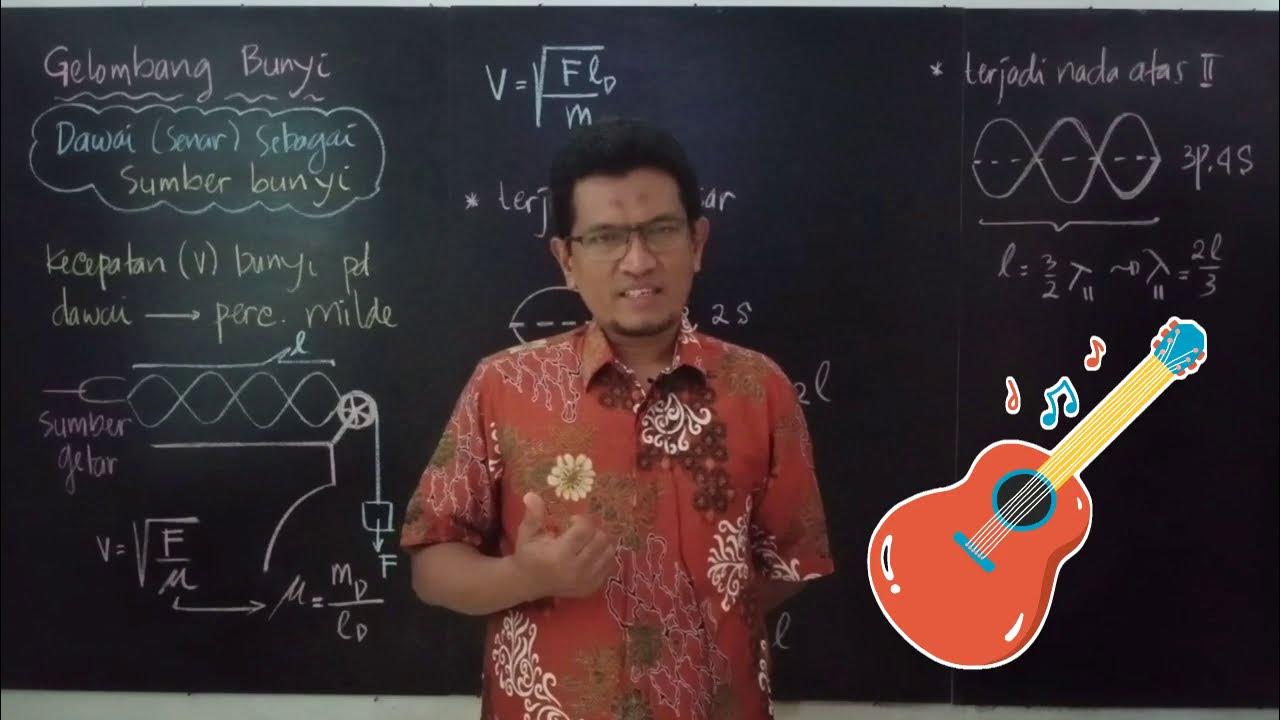GETARAN & GELOMBANG ( AMPLITUDO, PERIODE, FREKUENSI GETARAN)
Summary
TLDRThis script delves into the concept of vibrations, exploring their role in daily life, such as in musical instruments like guitars, the voice, and even in spider webs. It explains how vibrations occur and provides an example of a pendulum's oscillation. The script covers key physics terms such as amplitude, period, and frequency, highlighting their relationships. It also discusses the inverse relationship between period and frequency, offering examples and mathematical equations to clarify these concepts. Additionally, the impact of string length on the period and frequency of oscillations is explored in the context of a simple pendulum.
Takeaways
- 😀 Vibrations are a common phenomenon in daily life, seen in music, voice, spider webs, and vehicle suspensions.
- 😀 A vibration refers to a repetitive back-and-forth movement around a central point known as the equilibrium position.
- 😀 The restoring force in a vibrating system works to return the object to its equilibrium position after being disturbed.
- 😀 A complete vibration cycle is considered one full swing from one extreme to the other, passing through the equilibrium point.
- 😀 The amplitude of a vibration is the maximum displacement from the equilibrium position, measured from the center to the furthest point.
- 😀 The period of a vibration is the time taken for one complete cycle of movement, typically measured in seconds.
- 😀 Frequency is the number of vibrations per second, measured in Hertz (Hz), and is the inverse of the period.
- 😀 The period (T) of vibration can be calculated using the formula T = t / n, where t is the total time, and n is the number of vibrations.
- 😀 The frequency (f) can be calculated using the formula f = n / t, where n is the number of vibrations, and t is the total time taken.
- 😀 Period and frequency are inversely related, meaning as one increases, the other decreases. The mathematical relationship is T = 1/f and f = 1/T.
- 😀 The length of a pendulum affects its period and frequency: longer pendulums have a larger period and smaller frequency, while shorter pendulums have the opposite effect.
Q & A
What are some examples of vibrations in daily life?
-Examples of vibrations in daily life include the vibration of a guitar string producing music, the vibration of vocal cords creating sound, spider webs vibrating to detect prey, and car suspension springs absorbing bumps to provide comfort while driving.
What is meant by the equilibrium point in the context of vibrations?
-The equilibrium point is the position where an object is at rest during a vibration. It is the point the object passes through during its oscillation, and when the object is at rest, it is in equilibrium.
What causes a pendulum to oscillate?
-A pendulum oscillates because of a restoring force that pulls it back towards its equilibrium position. When the pendulum is displaced from this point, the restoring force causes it to move back and forth.
What is amplitude in terms of vibration?
-Amplitude refers to the maximum displacement of an object from its equilibrium position during vibration. It is measured from the equilibrium point to the furthest point the object reaches during its oscillation.
How is the period of a vibration defined?
-The period of a vibration is the time it takes for the object to complete one full cycle of its oscillation. It is measured in seconds and can be calculated by dividing the total time by the number of vibrations.
What is frequency and how is it calculated?
-Frequency refers to the number of complete vibrations that occur in one second. It is measured in Hertz (Hz) and can be calculated by dividing the total number of vibrations by the time taken for those vibrations.
What is the relationship between period and frequency?
-Period and frequency are inversely related. The period is the time taken for one full vibration (T), while the frequency is the number of vibrations per second (f). The mathematical relationship is expressed as T = 1/f and f = 1/T.
How do you calculate the period if the frequency is known?
-To calculate the period when the frequency is known, use the formula T = 1/f. For example, if the frequency is 2 Hz, the period would be 1/2 = 0.5 seconds.
How do you calculate the frequency if the period is known?
-To calculate the frequency when the period is known, use the formula f = 1/T. For example, if the period is 0.5 seconds, the frequency would be 1/0.5 = 2 Hz.
How does the length of the pendulum affect its period and frequency?
-The length of the pendulum directly affects its period and frequency. A longer pendulum results in a longer period (slower oscillation) and a lower frequency, while a shorter pendulum results in a shorter period (faster oscillation) and a higher frequency.
Outlines

This section is available to paid users only. Please upgrade to access this part.
Upgrade NowMindmap

This section is available to paid users only. Please upgrade to access this part.
Upgrade NowKeywords

This section is available to paid users only. Please upgrade to access this part.
Upgrade NowHighlights

This section is available to paid users only. Please upgrade to access this part.
Upgrade NowTranscripts

This section is available to paid users only. Please upgrade to access this part.
Upgrade NowBrowse More Related Video

Gelombang Bunyi Pada Dawai (Senar) | Materi Fisika Gelombang Bunyi Kelas 11 SMA

IL SUONO E L'UDITO - scuola primaria e superiore

Sound Waves

Saiba como funciona uma onda sonora e como se dá a percepção do som.

Class 11 CBSE music | All definitions - Naad, Shruti, swar, saptak, thaat, jati, laya, taal

DAWAI (SENAR) SEBAGAI SUMBER BUNYI | Gelombang Bunyi #1 - Fisika Kelas 11
5.0 / 5 (0 votes)